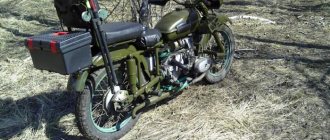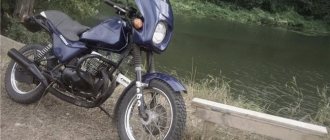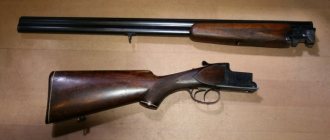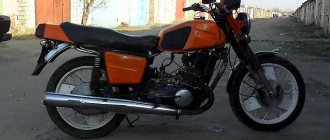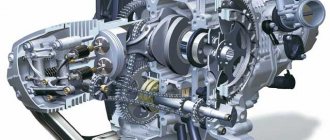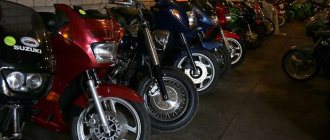Let's talk about the skeleton of a racing motorcycle - the frame and suspension. To understand all the intricacies, first compare the chassis of a motorcycle and a car. In a simplified way, a car can be imagined as a rigid chassis with four independent suspensions (we do not take into account the work of the transverse stabilizer, since it only to a small extent connects the work of the suspension). Regardless of whether we are braking or accelerating, the chassis geometry does not change, and the wheels handle road unevenness almost independently. Moreover, the unsprung mass and the gyroscopic effect of the wheels are negligible compared to the mass and torque of the vehicle as a whole. And one last thing. The driver's position does not affect the behavior of the car in any way. With motorcycles everything is much more complicated.
The Ducati 999 superbike frame has been strengthened compared to the original road version.
When braking hard, almost the entire weight of the motorcycle is transferred to the front wheel. Because of this, the fork is compressed almost to the end of the power stroke, which leads to colossal changes in chassis geometry. The base is reduced, the fork angle and offset are changed. About the same thing happens when accelerating. The only difference is that the monoshock absorber is compressed. So, in essence, almost everything affects the geometry of a motorcycle chassis. But these are still flowers.
Scuff marks on the adjustment unit indicate numerous settings changes.
The berries start at the turn. While the motorcycle is riding vertically, the contact patches of the front and rear wheels are on the same straight line and in the same plane as the center of mass. But in an inclined position this is no longer the case. The contact patches “move” away from the vertical axis of the motorcycle, and the stronger the slope and the wider the tires, the further! The resulting asymmetrical forces (the tire widths are different!) literally twist the motorcycle, and the centrifugal force compresses the fork and monoshock almost to the end. Enormous stress is transferred to the frame, and it now has to resist not only twisting, but also bending.
The picture is completed by the pilot himself, who, unlike the driver of a car, has a huge influence on the position of the center of mass of the motorcycle and, by changing the landing, is able to significantly change its behavior. Add to this the gyroscopic moments of the wheels, comparable in magnitude to the moment of the motorcycle itself, a large (relative to the mass of the bike) unsprung mass and the reverse steering effect (counter-steering), and even this greatly simplified picture turns out to be many times more complex than that which arises in cars .
The Ohlins laboratory is located in a large truck
What further compounds the complexity is that, unlike a car chassis (which is usually made as rigid as possible), a motorcycle frame must have a standardized rigidity, and here’s why. Once again, imagine a motorcycle in a tilted position. If the cornering speed is high enough, a situation may arise when both the front and rear suspensions are compressed by 100% under the influence of centrifugal force. If this happens, then any small bump will lead to loss of traction and a skid (or fall). But even if the suspension is not fully compressed, the vector of force applied to the wheel during a turn is not directed exactly in the direction of compression of the suspension, but at a certain angle. It is difficult for the fork and pendulum to cope with such forces, because they are designed to work only in the direction of their stroke. Therefore, the bending rigidity of the frame can only be increased to a certain limit, so that it plays the role of a kind of spring and absorbs hard lateral loads that the suspension cannot cope with. Moreover, increasing the rigidity of the frame often entails making it heavier. And excess weight, as you know, is our enemy.
In drag racing, pendulum stiffness is not as important as in circuit racing.
The last “against” of excessive rigidity is the loss of information content. The fact is that the pilot feels how the motorcycle holds the road while riding precisely due to the vibrations that occur in the loaded chassis. If the frame is made too rigid, then some of these vibrations will disappear or their amplitude will decrease, and it will be more difficult for the rider to recognize the edge of the rubber adhesion to the asphalt.
Ohlins racing fork damping is separately adjustable for high and low compression rates
On the other hand, we all know very well what happens if the frame is too flexible. Handling deteriorates, the motorcycle tends to wobble, and precise steering becomes difficult. So it turns out that, unlike a car, where the stiffer the chassis, the better, the rigidity of a motorcycle frame should correspond to the golden mean.
Having dealt with rigidity, let's talk about what the frames of modern sportbikes are made of. Stupid question - made of aluminum, of course! It makes it easier to “program” flexibility/stiffness exactly in those frame nodes where it is needed. This is done by accurately calculating the thickness of the frame walls, and increasing or decreasing it in very small increments (1mm or even less). The second material from which the frames are made is chrome-molybdenum steel. Unlike aluminum frames, steel frames are made mainly tubular (Ducati, Agusta, Benelli), and the rigidity is programmed with various configurations of “triangles”* welded from these same pipes. The advantage of this approach is the comparative ease of manufacture. It is much easier to weld steel pipes than to cast and then weld aluminum. The downside is that it is more difficult to obtain less weight, because steel is much heavier than aluminum.
Carbon frames have not yet taken root in the world of motorcycle racing.
The third option is one of the most exotic. Carbon frames. It would seem that carbon is the ideal material for such applications. Indeed, in auto racing and especially in F1, carbon has proven itself very well in the manufacture of monocoque chassis. But in motorcycles, as experience has shown, this is not the case. As we remember, in a car the chassis rigidity should be as high as possible - this is why carbon chassis work so well in F1. But it is very difficult to obtain a standardized rigidity of a carbon frame with high accuracy. Once upon a time, GP pilots actively tested motorcycles with carbon frames, but almost all of them complained about low information content and difficulties with the feel of the rubber.
The fork angle is adjusted by replacing shims
The second disadvantage of carbon fiber is its complete irreparability. Carbon fiber cannot be welded, glued, soldered or riveted. Therefore, in the event of an accident, the carbon frame was simply thrown away when damaged. And third, most important. Pilots quite often ask to change the frame stiffness (we’ll find out why a little later). It is clear that, unlike aluminum and steel frames, carbon construction will not allow this.
Another “nail” hammered into the coffin of carbon frames is the very poor repeatability of their parameters. Even frames manufactured according to the same drawings on the same equipment can differ significantly in rigidity. Because of this feature, the behavior of motorcycles with carbon frames was sometimes, to put it mildly, unpredictable.
The frame and swingarm of the Ducati Desmosedici are connected to each other via the engine
The last version of the frame is when there is no frame at all! Remember road BMWs, where the engine is the load-bearing element? But this approach also did not take root in motorcycle racing, and for the same reason as carbon frames: it is difficult to obtain the calculated stiffness. It is still partially used, for example, in the Ducati Desmosedici the swingarm is attached not to the frame, but directly to the engine, and in some road motorcycles the engine is a loaded part of the chassis**.
R1 swingarm strengthened for racing use
Another interesting point in the conversation about frames is typical for the SBK championship. The fact is that the frames of road motorcycles, unlike the MotoGP “farms” born for the track, do not always meet the needs of pilots. The frame stiffness may not be sufficient to withstand racing loads, and the geometry may be too stable, i.e. making it difficult to make quick turns. Therefore, the chassis of motorcycles participating in WSB and BSB are often modified - they are made stiffer and adjustment units are added. The rigidity of the frames is increased by welding additional aluminum parts, and chassis geometry adjustment units (if the stock bike did not have them) are added by installing tuning crossbars and a pendulum axle. Racing triple clamps allow you to change the fork angle and often its offset by replacing or turning a special eccentric. The position of the pendulum axis changes in the vertical and longitudinal planes also with the help of an eccentric and allows you to change the base and angle of the pendulum.
In endurance racing, the pendulum stiffness is often reduced
Let's talk about the pendulum in more detail. The technical regulations of the SBK championship allow the use of both modified stock products and the installation of tuning ones developed “from scratch.” The first option is budget-friendly and available to almost everyone, but a pendulum from Harris or Spondon will significantly lighten the buyer’s wallet. I’ll immediately make a short digression on the topic of endurance racing. Everything here is traditional – with a “zh”. Unlike the MotoGP and SBK championships, in Endurance the rigidity of the pendulum is not only not increased, it is reduced! Even worse, the pendulum is being lengthened!! Why? Yes, because handling in this class of racing equipment comes in second place after the comfort of the pilot and the ease of control of the motorcycle. After all, he has to travel for long hours. And rider fatigue slows the bike down much more than reduced swingarm stiffness.
The racing chain tensioner has a larger adjustment range and is more convenient to operate.
Another feature of the endurance bike's swingarm is the quick wheel changer*** - a sport biker's dream. It allows you to change the rear wheel in a few seconds due to the fact that the sprocket and chain are attached to the pendulum and when removed the wheels remain in place. There is no need to adjust the chain tension, nor do you have to suffer with numerous bushings that constantly fall out. Eternal thrill!
Chain tension and rear wheel position adjusters are often replaced with Spondon products, and not only in Endurance. The fact is that stock units are made to be budget-friendly, which is why they often do not provide accuracy (remember how a wheel tuned precisely to the risks still looked to the side?) and rigid fixation of the wheel axle when mechanics tighten the nut (sometimes the axle is this shifts). Tuning chain tensioners are designed to protect you from these troubles.
The compression damping of the WP shock absorbers is also adjustable for high and low speed suspension travel.
Having figured out (if you can figure it out at all!) with the design of the motorcycle chassis, let’s move on to the suspension. The familiar fork and monoshock absorber, it turns out, also hide interesting secrets. Firstly, why a fork? After all, its disadvantages have long been known (increased internal friction under load and the effect of this same load on steering). Indeed, there have been attempts (and not so unsuccessful) to create a front suspension that would separate two processes: the actual operation of the suspension and steering. Let's remember Paralever from BMW, Honda Elf with cantilever front suspension, or even the exclusive Virus. But the pilots of the racing teams one by one rejected all these technical miracles in favor of the traditional fork with all its shortcomings. What's the secret? It's about the feel of the front wheel. Only a classic fork provides the pilot’s hands with a direct connection to the wheel and allows you to feel even the slightest vibrations created by the rubber when in contact with the asphalt. In other cases, numerous hinges and joints mask these vibrations and it is more difficult for the pilot to determine what level of grip is available to him.
Compression damping is separately adjustable for high and low speed suspension travel
How do “golden” racing forks differ from their “silver table” road counterparts? First of all, the precision of manufacturing of internal parts and the materials used (anodized aluminum and titanium are widely used). Secondly, the fork design is different. Damping functions are often divided between the feathers: one is responsible for compression, the other for rebound. And of course, we all remember that many racing forks are gas-filled. This allows the feathers to be filled with hydraulic fluid (it is quite far from the oil) almost to the top, which eliminates the difficulty of selecting the level and completely eliminates the formation of air bubbles. Moreover, hydraulic fluid under pressure is less likely to experience physical phenomena such as cavitation.
TTX36 series shock absorbers are used on both racing and road motorcycles
In short, cavitation is the process of formation of bubbles in a liquid medium in front of a rapidly moving solid body. Our body is a piston that moves under the influence of road irregularities in the hydraulic fluid of the fork. If the unevenness and speed of movement are high, then the speed of movement of the piston in the fork can also be very high. The result is the formation of bubbles and “failure” of the piston. If the liquid is under pressure, then cavitation occurs to a lesser extent. For the same reasons, the rear monoshock absorber is also made gas-filled.
Having dealt with the front suspension, let’s briefly touch on the monoshock absorber. Unlike the fork, it is not directly connected to the pendulum, but acts on it through a system of levers****. This allows the rear suspension to provide a progressive response when using a linear spring shock absorber. But unlike their road counterparts, racing motorcycles have a more linear lever system. The reason is the smoother surface of the tracks. Another important point related to the motorcycle chassis is the pilot’s seating position. Many people often forget and neglect the role of the pilot when operating a motorcycle. This is mistake. If you ensure the correct fit of the racer during the race, you can achieve an increase in the adhesion of rubber to asphalt by even 20-30%. The exception is endurance racing. Here the landing is adjusted towards comfort. The reason, I hope, is clear.
Ohlins racing laboratory uses spring stiffness measuring device
The seating position is characterized by a triangle, the vertices of which are connected to the clip-ons, saddle and footpegs. The higher the peaks associated with the saddle and footpegs and the lower the peaks associated with the handlebars, the more of the rider's weight is redistributed forward. And vice versa. Adjustable clip-ons and footrests are used to adjust the fit.
The road version of the Foggy Petronas motorcycle is equipped with an Ohlins road sports fork.
An interesting nuance. Racing clip-ons are made of two parts: a clamp and a tube (unlike road clip-ons, which are a single unit). This allows you to repair a clip-on damaged by a fall without removing the fork stays. When it comes to running boards, they are often made using bearings. This allows you to remove even the slightest backlash and help the pilot avoid “mistakes”. In addition, the footrests must be rigid (non-folding). This is done for the sake of safety, partially protects the motorcycle in case of falls and better transfers chassis vibrations to the rider’s legs.
To conclude our highly scientific conversation about the chassis and suspension of racing motorcycles, I would like to talk about the difficulties that arise with these components. Many of them (and options for dealing with them) have been described previously, so we will look at the most complex variety: chatter. In short, these are resonant harmonic oscillations that occur in the motorcycle chassis at full tilt and most often at neutral throttle. The oscillation frequency lies in the range of 18-23 hertz, but is usually equal to 20Hz, i.e. 20 times per second. And the amplitude of these vibrations is sometimes so great that pilots’ teeth chatter and their vision blurs. In such conditions, naturally, it is impossible to squeeze everything out of the motorcycle, and the pilots are forced to let off the gas. Or fall. To make it easier to understand this complex physical phenomenon, you can simply imagine a motorcycle in the form of a tuning fork. As long as the ends of the “fork” do not touch anything, it sounds, i.e. fluctuates. If you touch at least one of the ends of the tuning fork with your finger (especially both), then the vibrations will quickly die out. This is why chatter rarely occurs during acceleration and braking. But a motorcycle is not a tuning fork, but a much more complex oscillating system.
Experimental frame vibration damper tested by Yamaha team to combat chatter
Chatter consists of a huge number of vibrations: suspension work, frame bends, rubber deformation, engine vibrations, cladding vibrations, the nature of the track and even the movements of the pilot. If some (which is not exactly known) of them resonate, a chat may begin. Therefore, it is monstrously difficult to fight him. He is even called the “ghost” of modern racing. In one turn it appears “out of nowhere” and completely paralyzes the rider and the motorcycle. And in the next turn or on another track it also suddenly disappears. The only thing that is reliably known about it is that it appears only when the rubber has good grip on the asphalt. This is why chatter does not occur in wet races and, on the contrary, is rampant during qualifying.
However, racing teams have nevertheless accumulated some knowledge about this “ghost” of speed. Based on the results of analyzing a huge amount of telemetry data and comparing it with frame parameters, the designers came to the conclusion that the chatter is in a certain dependence on the balance of the coefficient of adhesion between rubber and asphalt and the rigidity of the frame. If this balance is disturbed, the motorcycle begins to have seizures of “epilepsy.” Otherwise, the chatter remains unpredictable: it appears and disappears for no apparent reason and is little subject to chassis settings.
Author Anton Barsukov, photo by the author and producers.
The Yamaha M1 swingarm has very high rigidity in the plane of the suspension. In racing forks, compression damping is adjusted by the rigidity of steel spring washers. The position of the pendulum is adjusted by replacing bushings. Racing suspension elements are of higher quality and more precise than road counterparts. An adjustable crossbar allows you to change the angle of the fork. Huge racing loads are the reason for installing reinforced pendulums. Shock absorbers Showa is used by racing teams along with Ohlins. The Foggy Petronas race bike features a gas reservoir fork.
* As we remember from the strength of materials, the triangle is the most rigid figure. ** For example, R1 1998. *** Produced by Spondon Engineering. **** In the Honda Pro-link rear suspension, the monoshock absorber is not directly connected to the frame.
Frame from scratch
Summer is coming to an end and it’s time to start new projects. Many people here ask how to make a frame from scratch? So I decided to write a short article on this matter. In principle, there are different ways to do this, I will describe the method that I use and so far, it has not let me down.
Summer is coming to an end and it’s time to start new projects. Many people here ask how to make a frame from scratch? So I decided to write a short article on this matter. In principle, there are different ways to do this, I will describe the method that I use and so far, it has not let me down.
I usually start by selecting units for a future project. By components I mean - (front fork, wheels, tank, engine, gearbox, shock absorbers) After that, I take measurements of all these devices and draw them to scale on drawing paper. Of course, you can do this in different programs, like Pavel Obozov from https://www.brayvo.ru, but I’m still not good at modeling it, since he and I do everything on graph paper. In principle, when starting to make any boxer, you can take the engine drawing from any book about these motorcycles as the basis for the layouts. Such a book is taken and a drawing is copied from it (so as not to spoil the book), after which this copy is pasted onto whatman paper and cut out along the contour, preferably with maximum accuracy. Now you can start calculating the scale. Since in books the engine drawing is given without distortion (checked), we can safely measure a couple of parts on the engine and on the drawing, after which, to obtain a scale, we divide the dimensions taken from the original by the dimensions of the drawing. We get a number that is scaled (1:5). Of course, there will be errors, but they will be very insignificant, no more than 5-10 mm. In our case, this is not such an error that we should pay attention to it. It would also be nice, if you are making a frame for yourself, to make a model of yourself, also to scale. This helps a lot with frame layout and for the best fit. So, now we have something to start from, that is, an engine, there is a scale, and there is someone who will drive it all (also on a scale). Next, we measure all the extracted parts and calculate their sizes on a scale. Now you can start drawing the frame. First you need to make a side view of it. This will make it much easier to work with, and you will immediately understand what to put where and what it will look like. After the side view is constructed, you can draw the bottom view, top view, front and rear views. I don’t do this, because for me, in the process of drawing a side view, all the other views in the sketches are formed and this is enough for me, especially during the welding work, since something new will definitely come up.
Now I want to talk a little about the materials (pipes) from which to make the frame. Many people are looking for solidly drawn pipes, but as practice shows, this is not at all necessary, since foreign car manufacturers make them from seamed pipes (tested by cutting imported frames). I use pipes of the DIN 2440 brand, here they can be found in Russia - https://www.metaltorg.ru (this is not an advertisement) For the frame I use pipes of two diameters - 33.7 mm, wall 3.2 mm and 26.9 mm, wall 2.6 mm. You can also use corners of the same brand; they are very convenient for making sharp 90-degree turns without racking your brains about how and where to bend the pipe so beautifully. Smoother bends are made using a simple pipe bender. I would also like to note that in load-bearing areas it is necessary to make inserts at the joints of the pipes and leave a gap of 3-4 mm between the pipes for the welding seam. It is better to bend pipes according to templates made in full size from cardboard or plywood. Now that the pipes have been purchased and bent, you can proceed to assembling the frame on the slipway. The construction of the slipway was laid out on the opposite side and if anyone is too lazy to look, here it is - https://www.oppozit.ru/modules.php?name=News&file=article&sid=1040
Of course, before assembly you need to stock up on all the parts you want to have on the frame. Namely, the steering column, all kinds of brackets, and so on. Of course, it is better to weld the frame using a semi-automatic machine, but if someone does not have access to such a unit, then it is possible to use electric arc welding. Cooking with gas is not a very good option, unless of course it is argon.
These are, in principle, all the tricks of the frame from scratch, but everyone can add their own knowledge and you will get a very good frame, and most importantly, it is made by you personally and no one will have a second one. I wish you success.
A little history
The progenitor of the “Soviet Harley” appeared in the late 20s of the twentieth century.
At first it was a model designed by Mozharov on the basis of IZH and PMZ, but with a heavy frame and a 1200 cc engine that consumed a lot of fuel, it had a power of only 24 HP and lost control at speeds above 60 km/h. Therefore, it was decided to adopt European experience and use the advantages of the BMW R-71. Naturally, the German was not repeated completely, but only borrowed some ideas, adapting them to the realities of the USSR. In particular, they installed a double-disc clutch, increased the gear ratio and tank volume, increasing cross-country ability.
Complex modifications
They are carried out after obtaining special permits, are usually internal and most often come down to the adoption of the following modernization measures:
- Installation of a new muffler - if this point is not agreed upon in advance, problems will arise when passing the technical inspection.
- Changing the frame design must be carried out on the basis of precise calculations approved by specialists, because this is the main supporting element, the strength of which determines the overall reliability, stability and maneuverability of the vehicle.
- Alteration of the brake system - installing discs instead of drums in order to increase efficiency is permissible only after receiving documentary permission from IMZ representatives. If you carry out such modernization without permission, then after the next inspection you can not only lose your rights, but also receive a fine or even a prison sentence.
The main difficulties here are in the preparation of documents, and all the work can be done independently without much difficulty.
Very often, tuning of Dnepr and Ural motorcycles is carried out not for the sake of cosmetic changes, but so that they become faster, more powerful, and more maneuverable. Let's look at what can be done.
Source
Modern Dnieper
This project is really attractive because there were ideas to make the motorcycle better. On the one hand, from the Dnieper there is basically only a motor
. A fork from some modern motorcycle is installed; one cannot help but rejoice at the presence of disc brakes.
Another thing is the level of execution of the planned alterations. Perhaps the project has not yet been completed
and the author plans to work on
cosmetics
, but so far appearance is not the strongest point of this device.
External tuning of the Dnepr motorcycle
As for external tuning, everything here can only be limited by your imagination, but before you do anything, look first at the Dnepr tuning photo, where you can see some modernization options. If you change the technical characteristics of the MT Dnepr, then this will significantly improve its appearance, because this model was initially limited to external features and some kind of plastic. An excellent option for external tuning would be to install additional indicators, an improved tachometer and speedometer on the motorcycle.
Most tuned motorcycles come in the form of choppers or sports versions, so to get a chopper from the Dnepr you will have to install an extended front fork. And to make your iron horse look like a chopper, it is recommended to install a disc brake system, which will also give the motorcycle an excellent appearance. Many specialists in the modernization of Soviet technology advise carrying out a procedure to lighten the entire structure of the Dnieper. To do this you will have to replace:
As a result, after replacing the above parts with lighter ones, you will get many positive aspects. Thus, the motorcycle will be easy to control, maneuverable, and speed indicators will be noticeably increased. Also, if you notice other heavy components or parts, if possible, replace them with lightweight analogues.
But even this is not the end of the external tuning of the Dnieper, because one of the standard methods is to coat parts with chrome. Unfortunately, this procedure is quite expensive, so experts have come up with an excellent alternative - the necessary part is coated with nickel.
What do you need to know when tuning?
If you have an MT Dnepr motorcycle that is several decades old, you should be aware of its main disadvantage - the fuel system. Unfortunately, this model from KMZ did not receive an ideal fuel system, so many will be interested in improving this characteristic through tuning. Also, Dnepr owners will be interested in improving the oil system by installing a high-quality oil filter.
Engine tuning
Tuning the Dnepr engine is caused by defects in the ignition and fuel systems. The first is corrected by installing electronics and a carburetor from a VAZ 2106 , the second is by replacing the standard centrifuge with an oil filter.
In the latter case, it is desirable to install additional oil channels, which entails altering the automobile oil pump. To create the pump housing, a metal blank is machined into which a cavity for the gears and axial holes are machined. Next, the fittings are cut in.
An adapter for the filter is also made independently. It contains two pressure reducing valves:
- Dumps excess oil to timing gears.
- By redirecting the oil to additional line, protects the crankshaft from lack of lubrication when the pressure drops to 1-2 atm.
This system allows for trouble-free lubrication of all elements with purified oil.
Spectacular bike
To create this masterpiece, a resident of Bashkortostan decided to attach a car wheel to a motorcycle. Parts from various vehicles were also used in the restoration.
The front brakes and fork came from the IZh Orion, the carburetor from the VAZ-2106, and the ignition from the Oka. After the repair, the motorcycle turned out to be impressive, its length was 2720 cm.
From the old Dnepr, only the gas tank and engine remained in the restored model. This motorcycle was restored back in 2007.
At that time, many social network users were delighted with the tuning. However, there were those who called the product impractical and inconvenient.
Heavy KMZ motorcycles have become famous for their strength and durability, which now remain their main advantages. These models do not allow enthusiasts to forget about the legendary technology and create unique cars on its basis.




